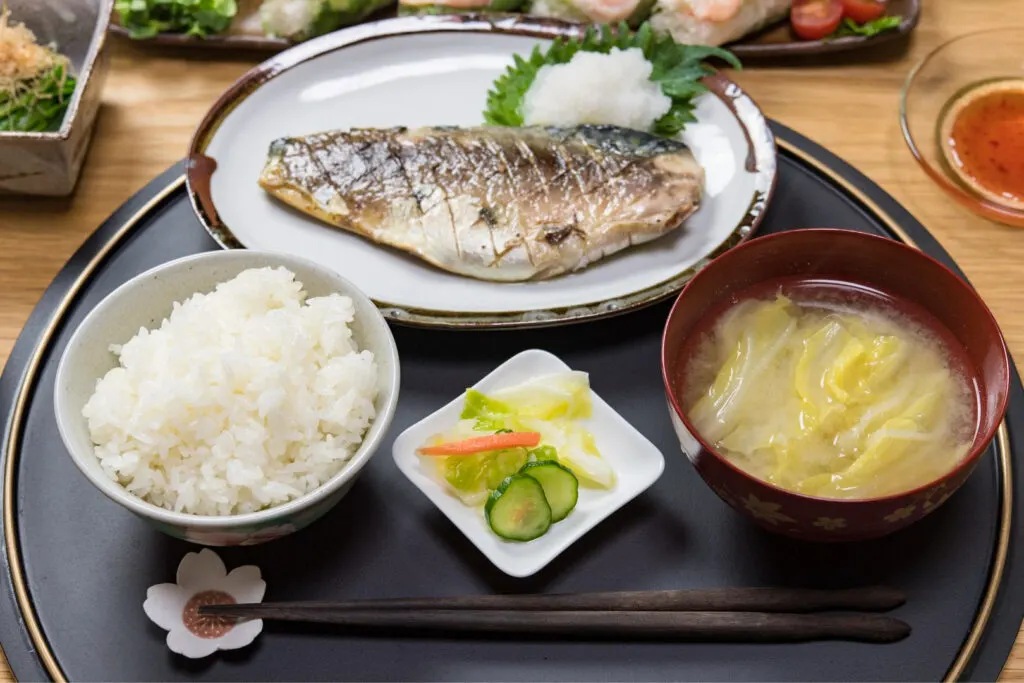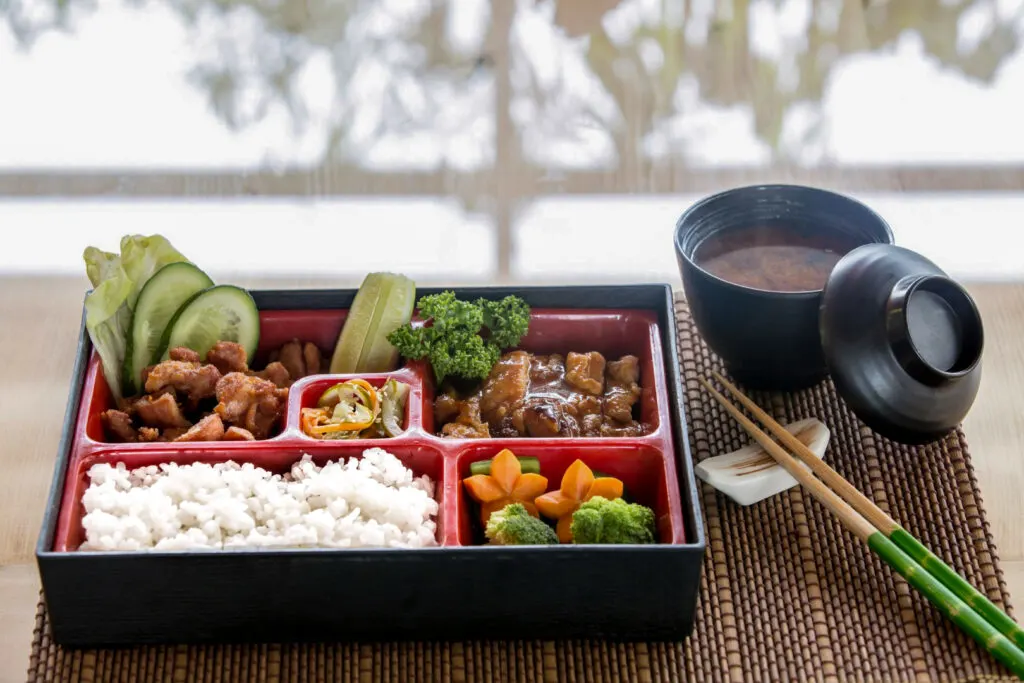If you have ever helped clean up after a casual Japanese meal at home, you may have been struck by just how many dishes you needed to wash. I know I was, and certainly not in a good way at first. At that time, my very Western mentality was along the lines of, “Excessive much?! Can’t we just use one plate?”
I urge you to set aside those biases and delve into the storied culture of Ichiju Sansai (一汁三菜, いちじゅう・さんさい), a traditional Japanese meal. Let’s step back and look at the cultural and traditional aspects that embody the essence of Washoku (和食, わしょく) or traditional Japanese cuisine, and then delve into the order and etiquette for eating it.
Table of Contents
What is Ichiju Sansai?
Before looking at the presentation of a traditional meal, we need to understand what dishes are included. Ichiju (一汁, いちじゅう, ichijū or ichijyū) literally translates as ‘one soup’, while Sansai (三菜, さんさい) means ‘three dishes’ (a main dish and two side dishes). Interestingly, the second kanji of ‘sansai’ (菜) is also found in the character for vegetable, which highlights the healthy ingredients that make up Japanese cuisine.
In addition, you’ll find rice, the main staple of a traditional Japanese meal, and a small side dish of pickled vegetables (both are assumed to be present without needing a specific reference in the name). Without counting the tiny, palate-cleansing pickles, there are five plates in a Japanese meal.

The Japanese ‘rule of five’
When discussing balance in food and other creative ventures such as architecture and art, the Japanese use the ‘rule of five’. In addition to the five dishes, it is seen several times in Ichiju Sansai.
The obvious one is taste. Japanese cuisine prides itself on a well-thought-out harmony of salty, sweet, bitter, sour, and umami (savory). The rule of five is also represented in the colors red, green, yellow, white and black, which, in turn, also helps with nutritional balance.
Five is also evident in the various cooking methods. Fried, simmered, steamed, roasted/grilled, and raw foods are usually included in every meal, which is meant to stimulate your five senses.
Placement of Food on the Table in a Japanese Meal
In Japan, there is a traditional custom of putting the most important things or people on the left (facing them), sajyōi (左上位, さじょうい). This extends to such extremes as seating arrangements at a table or meeting, the location of where someone sits in a car or train, and even where people stand in the elevator! This is also evident in Ichiju Sansai.
Let’s start with the rice and soup, that form the basis of the meal (主食, しゅしょく, shushoku). The rice is usually white, but occasionally, you’ll see brown rice (玄米, げんまい, genmai), multi-grained rice (十八雑穀, じゅうはち・ざっこく, jyūhachi zakkoku), or rice mixed with assorted ingredients (炊き込みご飯, たきこみ・ごはん, takikomi gohan). The rice is the star, so it’s placed on the left, closest to the eater, for easy access.
The soup or jiru (汁, じる) is often either miso-shiru (味噌汁, みそしる, miso soup), a miso-based pork/root vegetable soup called ton-jiru (豚汁, とんじる) or ushio-jiru, clam soup in a dashi broth (あさりの潮汁, あさりのうしおじる). As another staple, it is placed in the other easily accessible spot, upfront on the right.

Next up are the three dishes (おかず, okazu). These include the main dish (主菜, しゅさい, shusai), which, more often than not, is fish, although these days, pork or some type of fried food, such as fried chicken or gyoza, has also become quite prevalent. This is placed in the center or towards the back, right.
This always irked me because I felt like the leading food was so “far away”, but understanding that rice and soup are really the primary items, it starts to make more sense. The main dish is usually placed on a long rectangular or larger round dish and is not intended to be picked up while eating, as many smaller round dishes are.
The two smaller side dishes, fukusai (副菜, ふくさい), literally translated as the ‘assistant dish’, and fukufukusai (副副菜, ふくふくさい), the ‘assistant-assistant dish’, are placed around or to the side of the main dish (the same goes for the pickles). These side dishes are usually some type of vegetable, tofu, or seaweed and are carefully selected to ensure the balance of taste, color and various cooking methods are met. The pickles or tsukemono are referred to as kōnomono (香の物, こうのもの), meaning “fragrant things”.

The Order: How to Eat a Traditional Japanese Meal
So now you are sitting with all this food in front of you, but where do you begin? First of all, most Japanese people do not strictly adhere to this order, so anywhere you want to start is fine, but there are certainly natural habits and typical ways of eating in Japanese culture. In general, the Ichiju Sansai traditional order for consumption is soup, rice, and then dishes and repeat.
1. Firstly, it is customary to dip your chopsticks in the soup. This warms them up and prevents the rice from sticking to them. The warm sip of soup also aids digestion as it warms up your body in preparation for the food you are about to consume.
2. After tasting the soup, move on to the rice. Unlike children or many newbies to Japan, most people eat white rice with no topping. If this is hard for you, feel free to take a bit of the main dish or a side dish as a topper. However, I have read that putting the pickles on the rice is bad manners.
Over the years, Japanese friends and family have often had a giggle over the food or sauces I have covered my rice in, but no one has gotten offended to date.
3. After rice, begin tasting the other dishes. Start with the dishes that have a weaker flavor so the intense flavors don’t overpower the more mild flavors before you can get to them. Then, go back to the soup, and you start the cycle all over.
Eating this way helps your body stay warm and get full slowly with the rice while savoring all the other flavors. If you need a palate cleanser, eat some pickled vegetables. They also say that the pickled vegetables help with overeating because of the vinegar.
Lastly, when not eating, keep your chopsticks on the chopstick holder provided for you. It should be placed between you and your meal. Make sure the end of the chopsticks you eat with faces to the left.
Enjoying Ichiju Sansai
The Ichiju Sansai tradition can be traced back to the Muromachi period (1336-1573), which shows how much it has stood the test of time. But you would be mistaken to think it hasn’t changed at all.
Many restaurants have kept the foundational aspects of balance, presentation, and fresh, healthy ingredients but have put a bit of their own spin on it. In many cases, this means keeping the staples of the meal and changing the number of dishes. This doesn’t mean the amount of food is increasing but instead provides the opportunity for a more varied number of tastes, cooking methods, and, of course, the chance to display them in a fresh, modern way. So don’t be surprised if you come across a meal reminiscent of Ichiju Sansai that looks slightly different.

The next time you eat Japanese cuisine, especially if you are wary because you don’t know what the food is, consider this attention to detail and enjoy the beauty and precision that went into planning that meal. There really is something special to it.
I know when I first came to Japan, there were many rules of etiquette that I couldn’t understand or didn’t necessarily want to follow, but the more I eat these meals, the more I can see and taste the importance behind this tradition. A culture that works tirelessly to present something that is so visually beautiful, exceptionally healthy, and unbelievably delicious definitely demands our respect.
Don’t forget to say “Itadakimasu” (いただきます) before you start eating and “Gochisōsama” (ご馳走様, ごちそうさま) when you’re done!
Devon Furuta grew up in Colorado, a place that boasts more than 300 sunny days a year. It’s no wonder she now finds herself in the sunniest place in Japan, Yamanashi.
With that inherited sunny disposition, she works to brighten the days of those around her through teaching, writing, and translation. You’ll also often find her messing around with musical instruments, reading Japanese novels, or pruning the many trees in her garden.
